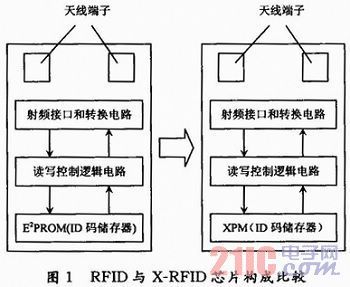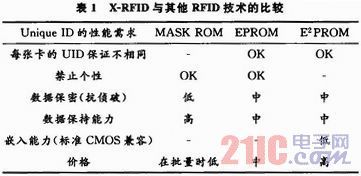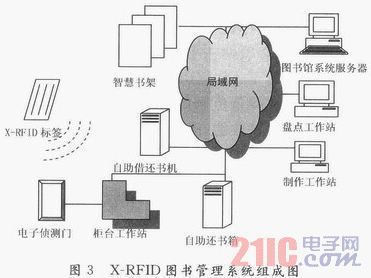0 Preface
The daily service of the library involves the management of the flow of people and logistics, and requires a large number of readers and books to identify, access control, and statistics. At present, libraries basically use barcode technology as a recognition method to achieve these functions. However, although bar codes have the advantages of cheap price and convenient production, they also have some inherent shortcomings that are difficult to overcome. For example, because they are easy to wear, they must be affixed to the book, which causes inconvenience to use and is not completely suitable for libraries. The new X-RFID technology that combines XPM and RFID can effectively overcome the shortcomings of barcodes, has large-capacity, high stability and long-life storage performance, and can realize many new functions that barcodes cannot achieve. The development and utilization of these new functions will give The traditional service work of the library has brought revolutionary changes.
1 The concept and characteristics of X-RFID
That is, radio frequency identification (Radio Frequency Identification, RFID) has the advantages of non-contact, long working distance, suitable for harsh environments, and identifiable moving targets. It automatically recognizes target objects and obtains relevant data through radio frequency signals. The identification work does not require human intervention and can work in various harsh environments.
Super permanent memory (XPM) is a new type of non-volatile memory (NVM) technology. It uses a 100% deep sub-micron standard CMOS process, which is the same as manufacturing logic circuits (CPU, DSP, etc.), without adding a floating gate process. Practice has shown that XPM products have high reliability and are not easily affected by factors such as temperature, voltage, irradiation, and the number of read operations.
X-RFID uses XPM technology to apply to RFID chips, and uses XPM memory instead of traditional EEPROM as ID code storage device, so that the advantages of XPM memory can be concentrated. Can be widely used in logistics, retail, manufacturing, public transportation, medical and health, airports, railways, asset management, identification, security, property rights protection and military, etc., with low cost, high process compatibility, confidentiality High, physical non-erasable and other characteristics.
RFID and X-RFID chip structure comparison is shown in Figure 1.

The RFID system using XPM technology has more advantages than other RFID technologies (see Table 1).

2 The composition and working principle of X-RFID system
The X-RFID application system consists of 4 parts: a tag, an antenna, a reader, and a data management system, as shown in Figure 2.

X-RFID tag is the core of radio frequency identification system, also known as radio frequency tag, its English name is TAG, also known as LABEL. The electronic tag is the real data carrier of the radio frequency identification system. Under normal circumstances, the radio frequency tag is composed of a coupling element and a chip. Each tag has a unique electronic code, which is attached to the object to identify the target object; when irradiated by the radio frequency signal, it can be reflected back to the radio frequency carrying the alphanumeric coded information Signal for reader to process and identify. According to the different power supply methods of radio frequency tags, they can be divided into active tags and passive tags. Active tags are equipped with batteries, and passive tags have no batteries inside.
A reader is an electronic device that reads or reads / writes an electronic tag. It is sometimes referred to as a reader (Reading Device), an interrogator (Interrogator), a communicator, or a reader. It can be designed as a handheld or fixed type. The reader is a device for signal generation, transmission and reception. The radio frequency signal generated by it is amplified by a power amplifier and transmitted through an antenna. At the same time, the signal reflected by the tag is received, and the signal is separated by the radio frequency receiver, and then detected, Demodulate, amplify through preamplifier, send to readout computer for processing. When the tag enters the magnetic field, the reader sends a set of electromagnetic waves of fixed frequency to the tag through the antenna. There is an LC series resonant circuit in the tag, whose frequency is the same as the frequency emitted by the reader. Under the excitation of the electromagnetic wave, the LC resonant circuit Resonance occurs, so that there is a charge in the capacitor. At the other end of the capacitor, a unidirectional electronic pump is connected to send the charge in the capacitor to another capacitor for storage. This capacitor can be used as a power supply to provide working voltage for other circuits, transmit the data in the card or access the data of the reader, and restore the object information in the tag, so as to achieve the purpose of identifying the object. The antenna of the reader can be built-in or external.
The working frequency band of X-RFID, for radio frequency identification systems, the main frequencies are 0 ~ 135 kHz, and the ISM frequencies are 6.78 MHz, 13.56 MHz, 27.125 MHz, 40.68 MHz, 433.92MHz, 869.0MHz, 915.0MHz (in Europe Not used), 2.45GHz, 5.8GHz and 24.125GHz.
3 Application of X-RFID in the library
The use of RFID technology to automate library business requires that RFID tags have extremely high requirements on the data retention period, cost tolerance, and data security. According to the most common EEPROM-based RFID technology, Labels have the disadvantages of shorter data storage time, lower security, higher cost, and easy loss of data. Therefore, in various RFID technologies, the use of XPM technology is the most suitable for use in RFID library management systems. This not only effectively solves the data storage period and security, but also relatively reduces the operation and implementation costs of the RFID library management system, and also provides sufficient conditions for the wide application of RFID in the library industry.
X-RFID technology is mainly used in libraries such as self-service book stand, self-service book box, counter workstation, collection sorting system, machine inspection service station, electronic security door, bookshelf management system and so on. The intelligent library management system based on X-RFID is shown in Figure 3.

X-RFID tags can provide convenient data management and have anti-theft protection functions; the antenna mainly provides entrance and exit security work, it can accurately identify the title of each book that triggers the alarm, and the alarm is truly true; the counter The workstation is for the administrator to read the RFID code of the book when going through the borrowing and returning procedures, which is convenient for the library administrator to carry the handheld reader at any time to capture the information of the smart tag on the book, quickly search the book, and put the bookshelf on the shelf Book management classification; self-service borrowing and returning machine allows readers to handle borrowing procedures by themselves, it is composed of borrowing card reader, RFID reader, touch screen and a receipt printer; automatic sorting system, use The reader recognizes the label to achieve the purpose of automatic sorting; the application software is connected to the LAS and other components through the interface of the Ethernet through the interface of the SIP2, and connects the intelligent library management system with the library's circulation automation system. Readers and librarians bring convenience.
4 Advantages of using X-RFID system
4.1 Simplified process and improved efficiency
The current borrowing and returning process generally uses a barcode scanning system. The barcode data is collected by a fixed or hand-held barcode scanner. The barcode is easily damaged and is only suitable for close-range, static, and small data collection. In addition, the scanning operation requires manual Open the book and find the barcode location to scan, the operation process is more cumbersome, and the efficiency of borrowing and returning books is low. The introduction of X-RFID technology can realize a dynamic, fast, large data volume, and intelligent book borrowing and returning process, improve the security of information storage, the reliability of information reading and writing, and the speed and speed of borrowing and returning books.
4.2 System improvement, improved safety
Use X-RFID technology to improve the existing management system, link the anti-theft system with the book circulation management system, record the history of each book in and out of the library, so that it can be matched with the history of borrowed and returned books. It can effectively improve the accuracy of the anti-theft system and ensure the safety of books.
4.3 Reduced workload and improved job satisfaction
Due to the accumulated repetitive work of the library staff, the work itself is very heavy, such as relying on manual book inventory and heavy workload, it is easy to produce certain negative thoughts on the work; plus readers also express dissatisfaction with the library, leading to The work satisfaction of the library has declined. Through the transformation of X-RFID technology, the staff can be freed from the daily and repetitive labor of the library, and at the same time, the reader's satisfaction with the library work can be improved.
4.4 Strong data retention and long code life
Due to the physically non-erasable method, compared to the use of high-voltage electric boxes to store data, RFID data using EEPROM technology can be stored for up to 10 years, and X-RFID data retention can reach more than 100 years. Due to the non-contact reading method, coupled with the characteristics of waterproof, anti-magnetic and high temperature resistance, the life of RFID electronic tags is much longer than that of bar codes. Each electronic tag can be read at least 100,000 times. In this way, once the electronic label is attached, it can be used for a long time.
5 Conclusion
Due to the current status of the development of libraries in China, the promotion and application of X-RFID in the field of Chinese libraries are restricted by various factors, and it will take a long time to achieve. However, X-RFID can enable libraries to achieve real intelligent management. Through X-RFID technology, they can provide readers with simple and rapid self-service services, improve the efficiency of librarians, save labor for libraries, and provide security for readers environment of. The unique advantages of X-RFID are unmatched by other identification technologies. The X-RFID system is the development trend of library management systems. It will eventually replace and eliminate the currently widely used barcode identification technology. The application of X-RFID technology will Promote the construction and development of digital libraries in China.
Self Adhesive Vinyl Film,Self Adhesive Mirror Film,Self Adhesive Plastic Film,Self Adhesive Film For Furniture
Dongguan zuncheng paper plastic material co. LTD , https://www.zcadhesive-label.com